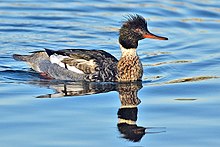Mergus
| Typical mergansers | |
|---|---|

| |
| Red-breasted merganser (Mergus serrator) | |
| Scientific classification | |
| Domain: | Eukaryota |
| Kingdom: | Animalia |
| Phylum: | Chordata |
| Class: | Aves |
| Order: | Anseriformes |
| Family: | Anatidae |
| Subfamily: | Anatinae |
| Genus: | Mergus Linnaeus, 1758 |
| Type species | |
| Mergus castor[1] Linnaeus, 1766
| |
| Species | |
|
† | |
Mergus is the genus of the typical mergansers (/mɜːrˈɡænsərz/ mur-GAN-sərz)[2] fish-eating ducks in the subfamily Anatinae. The genus name is a Latin word used by Pliny the Elder and other Roman authors to refer to an unspecified waterbird.[3][4]
The
The hooded merganser (Lophodytes cucullatus, formerly known as Mergus cucullatus) is not of this genus but is closely related. The other "aberrant" merganser, the smew (Mergellus albellus), is phylogenetically closer to goldeneyes (Bucephala).
Although they are
Mergus ducks are also classified as "diving ducks" because they submerge completely in looking for food. In other traits, however, the genera Mergus, Lophodytes, Mergellus, and Bucephala are very similar: uniquely among all Anseriformes, they do not have notches at the hind margin of their sternum, but holes surrounded by bone.[6]
Taxonomy
The genus Mergus was introduced in 1758 by the Swedish naturalist Carl Linnaeus in the tenth edition of his Systema Naturae.[7] The genus name is the Latin word for an unidentified waterbird mentioned by Pliny the Elder and other authors; some sources have identified the original mergus as referring to either a cormorant or Scopoli's shearwater.[8][9][10][11] The type species was designated as the common merganser (Mergus merganser) by Thomas Campbell Eyton in 1838.[12][13]
Recent species
The genus contains four living species and two recently extinct species.[14][15][16]
| Image | Scientific name | Common name | Distribution |
|---|---|---|---|

|
†Mergus australis | Auckland Island merganser | Auckland Islands, New Zealand (extinct c. 1902). The species identity of merganser bones from mainland New Zealand - North, South, and Stewart Islands - is unresolved.[17] |
 |
Mergus merganser | Common merganser | Europe, northern and central Asia, and North America |
| †Mergus milleneri | Chatham Island merganser
|
Chatham Island, New Zealand. Extinct sometime after human settlement of the Chatham Islands,[16] which began c. 1500.[18] | |
 |
Mergus octosetaceus | Brazilian merganser | Brazil |
 |
Mergus serrator | Red-breasted merganser | Northern North America, Greenland, Europe, and Asia |
 |
Mergus squamatus | Scaly-sided merganser | East Asia |
Fossil species
Some fossil members of this genus have been described:
- Mergus miscellus is known from the Middle Miocene Calvert Formation (Barstovian, c.14 million years ago) of Virginia, USA.
- Mergus connectens lived in the Early Pleistocene about 2–1 million years ago, in Central and Eastern Europe.[19]
The Early Oligocene booby "Sula" ronzoni was at first mistakenly believed to be a typical merganser.[20] A Late Serravallian (13–12 million years ago) fossil sometimes attributed to Mergus, found in the Sajóvölgyi Formation of Mátraszőlős, Hungary, probably belongs to Mergellus.[21] The affiliations of the mysterious "Anas" albae from the Messinian (c. 7–5 million years ago) of Hungary are undetermined; it was initially believed to be a typical merganser too.[22]
References
- ^ "Anatidae". aviansystematics.org. The Trust for Avian Systematics. Retrieved 2023-08-05.
- ISBN 0-550-10105-5.
- ISBN 978-1-4081-2501-4.
- S2CID 170648873.
- ^ "Common Goldeneye". Seattle Audubon Society. Retrieved 18 April 2014.
- .
- ^ Linnaeus, Carl (1758). Systema Naturae per regna tria naturae, secundum classes, ordines, genera, species, cum characteribus, differentiis, synonymis, locis (in Latin). Vol. 1 (10th ed.). Holmiae (Stockholm): Laurentii Salvii. p. 129.
- ISBN 978-1-4081-2501-4.
- S2CID 170648873.
- ISSN 2444-3565.)
{{cite journal}}: CS1 maint: DOI inactive as of January 2024 (link - ^ "Ornithological Approaches to Greek Mythology: The Case of the Shearwater" (PDF). CAMWS.
- ^ Eyton, Thomas Campbell (1838). A Monograph on the Anatidae, or Duck Tribe. London: Longman, Orme, Brown, Green, & Longman. p. 76.
- ^ Mayr, Ernst; Cottrell, G. William, eds. (1979). Check-List of Birds of the World. Vol. 1 (2nd ed.). Cambridge, Massachusetts: Museum of Comparative Zoology. p. 496.
- Rasmussen, Pamela, eds. (July 2021). "Screamers, ducks, geese & swans". IOC World Bird List Version 11.2. International Ornithologists' Union. Retrieved 24 August 2021.
- ^ "Auckland Island merganser | Miuweka | New Zealand Birds Online". www.nzbirdsonline.org.nz. Retrieved 2022-05-30.
- ^ a b "Chatham Island merganser | New Zealand Birds Online". nzbirdsonline.org.nz. Retrieved 2022-05-30.
- ^ Miskelly, Colin & Forsdick, Natalie & Gill, Brian & Palma, Ricardo & Rawlence, Nicolas & Tennyson, Alan. (2022). CHECKLIST OF THE BIRDS OF NEW ZEALAND. https://www.researchgate.net/publication/361824003_CHECKLIST_OF_THE_BIRDS_OF_NEW_ZEALAND
- ^ "Moriori | people | Britannica". www.britannica.com. Retrieved 2022-05-30.
- ^ Mlíkovský, Jirí (2002a). "Early Pleistocene birds of Stránská skála, Czech Republic: 2. Absolon's cave" (PDF). Sylvia. 38: 19–28. Archived from the original (PDF) on 2016-04-11. Retrieved 2008-08-05.
- ^ Mlíkovský (2002b): p. 264
- ^ Gál, Erika; Hír, János; Kessler, Eugén & Kókay, József (1998–99). "Középsõ-miocén õsmaradványok, a Mátraszõlõs, Rákóczi-kápolna alatti útbevágásból. I. A Mátraszõlõs 1. lelõhely [Middle Miocene fossils from the sections at the Rákóczi chapel at Mátraszőlős. Locality Mátraszõlõs I.]" (PDF). Folia Historico Naturalia Musei Matraensis (in Hungarian and English). 23: 33–78. Archived from the original (PDF) on 2011-07-21. Retrieved 2007-02-06.
- ^ Mlíkovský (2002b): p. 124
Bibliography
- Mlíkovský, Jirí (2002b): Cenozoic Birds of the World, Part 1: Europe. Ninox Press, Prague.
